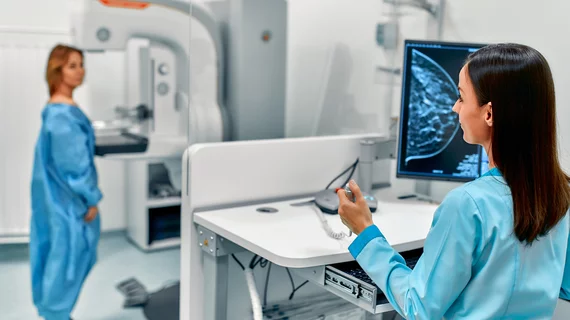Women who pay for mammography AI see higher cancer detection rates. But is this extra charge ethical?
Women who paid an extra out-of-pocket charge for artificial intelligence to read their mammogram experienced a “substantially higher” cancer detection rate, according to new research from industry giant RadNet Inc. But is such an approach ethical?
The Los Angeles-based imaging center operator offered its Enhanced Breast Cancer Detection program to patients across 10 healthcare practices for the study, presented this week at RSNA 2024. About 36% of women opted for the service, which costs $40 per person, and they were 21% more likely to have their cancer detected than those who did not.
“These data indicate that many women are eager to utilize AI to enhance their screening mammogram, and when AI is coupled with a safeguard review, more cancers are found,” study senior author Gregory Sorensen, MD, RadNet’s chief science officer, said in a Dec. 5 announcement from the Radiological Society of North America.
A total of 747,604 women underwent screening mammography during the study’s one-year timespan. Among those who opted for AI, the overall cancer detection rate on average was 43% higher. This pattern was observed across all 10 radiology practices, which ranged in size from a few sites up to 64. Deeper analysis revealed that about 21% of the cancer detection increase stemmed from AI, while the other 22% was due to high-risk patients choosing to enroll more frequently. The rate at which women were called back for additional imaging was about 21% higher in the AI group. Meanwhile, the positive predictive value for cancer was 15% higher for those who chose AI, “indicating that each recall resulted in more cancer diagnoses in the enrolled population.”
RadNet and its DeepHealth subsidiary hope to conduct additional research, better quantifying the benefit of AI via prospective, randomized controlled trials that would eliminate self-selection bias. Last year, the company delivered about 1.6 million mammograms, with leaders forecasting RadNet’s AI segment could generate upward of $18 million, with much of that coming from EBCD.
Questions about ethics
Though the study’s results are promising, some have previously questioned the integrity of only providing AI-based screening to those able to pay. For instance, new elective whole-body MRI scans, backed by artificial intelligence, are striving to unearth cancer and other diseases before they become symptomatic. However, with a price tag of $2,500, the benefit is likely limited to the wealthy.
“While AI holds great potential to improve screening, detection and treatment for breast cancer, its promise is still largely unknown,” Erica Kuhn, director of health information and publications at the Susan G. Komen foundation, a breast cancer care advocacy group, told Radiology Business by email. “We believe we must ensure the utilization of AI doesn’t inadvertently deepen disparities or create additional barriers to high-quality care due to increased costs, limited availability, lack of regulation and standardization or a design that doesn’t help all people.”
Reached Thursday, Sorensen said RadNet wishes that payer coverage for the Enhanced Breast Cancer Detection program was already in place. The company is currently in active conversations with several health insurers to establish reimbursement for more women, he told Radiology Business. When digital breast tomosynthesis was first introduced, many imaging centers only offered DBT to those who could pay, Sorensen noted. Eventually, this pressured payers to offer coverage, and now over 90% reimburse for DBT.
“We hope that EBCD will follow the same history: Temporarily women pay out of pocket, but eventually payers come around,” Sorensen said.
RadNet initially charged $59 or higher for the AI service but adjusted the price downward to $40. He noted that “very few women” have identified cost as a barrier to EBCD. RadNet is witnessing high adoption rates at its centers located in socioeconomically disadvantaged areas, and same for the MammogramNow centers located in Walmart superstores.
Sorensen emphasized that EBCD is “much more than AI, both in effort and in benefit.” This includes an expert breast radiologist providing a third “safeguard review” in instances where there was discordance between the first reader and AI. Absent EBCD, this would amount to additional duties for physicians, and it’s “not sustainable to think the radiologists will take on the extra work without compensation.”
“The reality of the U.S. healthcare payment system is that unless a price is in place over a period of time that is consistent for a service, no sustainable or durable payment is likely to be established,” Sorensen said. “We are optimistic, given the strength of the data and the positive feedback from both patients and employers—some of whom are already offering to cover EBCD for all their employees—that the out-of-pocket charge will be a temporary state.”

